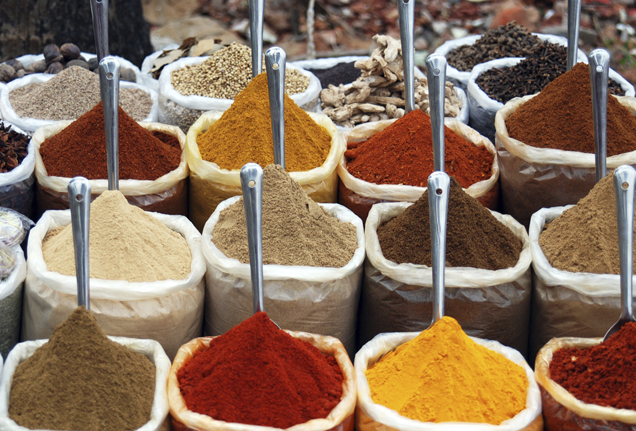India is a country that is often defined by numbers. It is home to a population of more than 1.2 billion people,it has a culture and heritage that spans more than 2,000 years, and is currently the world’s fourth largest economy (and growing at a consistently rapid rate). It is a land in which more than 16 languages are spoken and more than 36 distinct styles of cuisine are eaten. However, among this culinary diversity there is one element that binds these dishes together. Have you guessed? Yes, it’s the spices that feature so prominently in the food of the country that is the common factor.
Over the millennia, Indian spices have been lauded for their medicinal properties as much as for their flavour and food-preserving capabilities. But it is their taste that they are most known for these days. From the sweet fragrance of cardamom and the smoky richness of cumin seeds, to the pungent warmth of cinnamon and temperature-raising heat of potent chilli peppers – there is a spice that caters to every taste.
These aromatic spices are able to transform a dish and take the diner on a journey. A perfectly-spiced dish can conjure up memories of childhood or travels, or put an innovative twist on classic dishes that you previously thought couldn’t be improved. The only challenge is the sheer volume of spices on the market. However, with a bit of know-how and the key spices you can start to understand how spices affect and transform a dish. Here are India’s top-six seasonings:
Cumin seeds: Smoky in taste, cumin is a much-loved spice the world over. To make sure you get the best from cumin seeds, always dry roast them before adding to a dish. Also use them in moderation as they can overpower other flavours.
Mustard seeds: Able to pack a real punch, mustard seeds are a spice with personality. Add them to a pan of hot oil and they will sizzle furiously – which is your cuethat they are at their optimum in terms of flavour. Crush the seeds, use them whole or add to oil to create a versatile ingredient.
Turmeric: Making an appearance in virtually every Indian dish, turmeric gives Indian food its trademark vibrant yellow colour. Use it freely in whatever dish you choose, but remember a little bit goes a long way and too much can taste bitter.
Cinnamon and cardamom: The sweetness of these two spices should not just be kept for the end of a meal. Although fabulous in desserts, cardamom and cinnamon also work well with meat, rice and even in tea.
Red chillies: If you like your food with some heat, then you will be no stranger to chilli peppers. From the very mild to the uber spicy, depending on your taste. Make sure you choose wisely!
If you want food that is perfectly spiced and captures the essence of India then look no further than one of London’s fine dining Indian restaurants. The menu celebrates all that is great in Indian cuisine and is so much more than just a number on an Indian takeaway menu.

